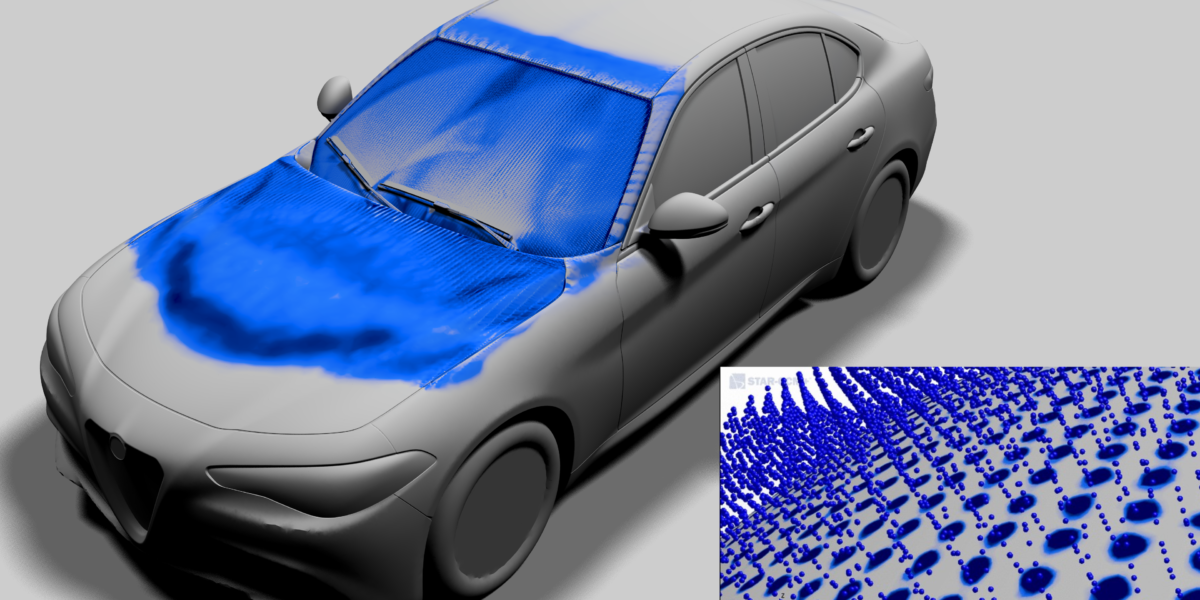Numerical CFD simulations allow the generation of increasingly accurate Digital Twins of machinery, representing real usage conditions. This makes it possible to evaluate scenarios that are difficult to recreate in experimental tests.
Cubit, together with the University of Pisa, supported the Alfa Romeo-Maserati group in developing an accurate simulation procedure for the behavior of a production car in rainy conditions. The focus was on the effectiveness of the windshield wipers and the absence of water infiltration in sensitive areas. Such collaborations achieve Cubit’s mission of creating a successful technological connection between academia and the industrial world.
The Digital Twin allows evaluating proposed solutions in the early design phase, allowing designers to make corrective changes without impacting production schedules. This optimization of design and time to market are decisive factors for competitiveness.
Usually, verifying the behavior of devices mounted on a car in rainy conditions is complex and costly, and it is done when the product is almost finalized and engineered, requiring significant investments in resources and time for any corrective actions.
The activity was carried out on a production car so that it could be easily replicated on new prototypes once completed. The chosen vehicle was the Alfa Romeo Giulia, known for its high performance and meticulous aerodynamic design achieved through wind tunnel tests and numerical methods.

Despite some necessary simplifications to minimize computational costs and streamline the procedure, the Digital Twin created is highly accurate and faithful in representing the real counterpart.
Prior to the fluid dynamics activity, research was conducted to define the most representative rain conditions, considering intensity, quantity, and size of water droplets that impact the vehicle. Additionally, careful characterization of the interaction modes between solid surfaces and liquid was performed.
Two promising and effective methodologies were identified at the state of the art:
- A Lagrangian treatment of liquid particle dynamics involving the VOF methodology to evaluate air-water interaction, introducing liquid into the domain via an injection grid, necessary for this type of analysis with these models.
- Introducing the Dispersed Multiphase model, which assumes the existence of a dispersed phase in another phase in the domain, providing a very realistic representation of rain presence.

In both cases, a fluid film was considered on the windshield, and an impingement model was used to evaluate the dynamics of the droplet upon impact with a solid surface.

To obtain realistic data on the effectiveness of the windshield wipers in removing water from the windshield, their motion was modeled using the overset technique, widely used in CFD. To represent the adhesion, the morphing mesh model available in the Star CCM+ environment was used.
All these features made the numerical simulation extremely complex, but they allowed not only to evaluate the macroscopic behavior of the car in rainy conditions but also to assess the design quality of the water recovery duct from the windshield and the possible water ingestion from the engine’s intake ducts and air conditioning system, a critical event for their functioning.

The procedure highlighted that the first methodology is sufficiently representative of reality and less computationally expensive, enabling simulating 20 seconds of operation in 10 days using 256 cores of Cubit’s cluster, compared to approximately 500 days required for the same results with the Dispersed Multiphase model, without a substantial increase in accuracy.
We thank Ing. Giacomo De Angeli, Performance Manager at Maserati, and Ing. Antonio Ercoli for their crucial contributions to the completion of this project.


